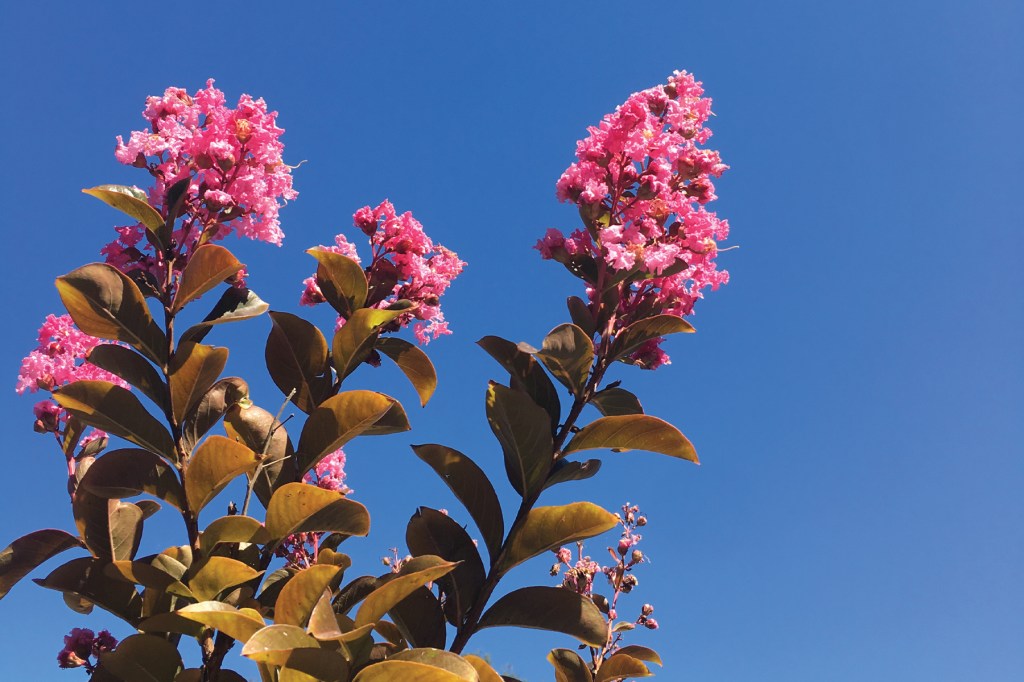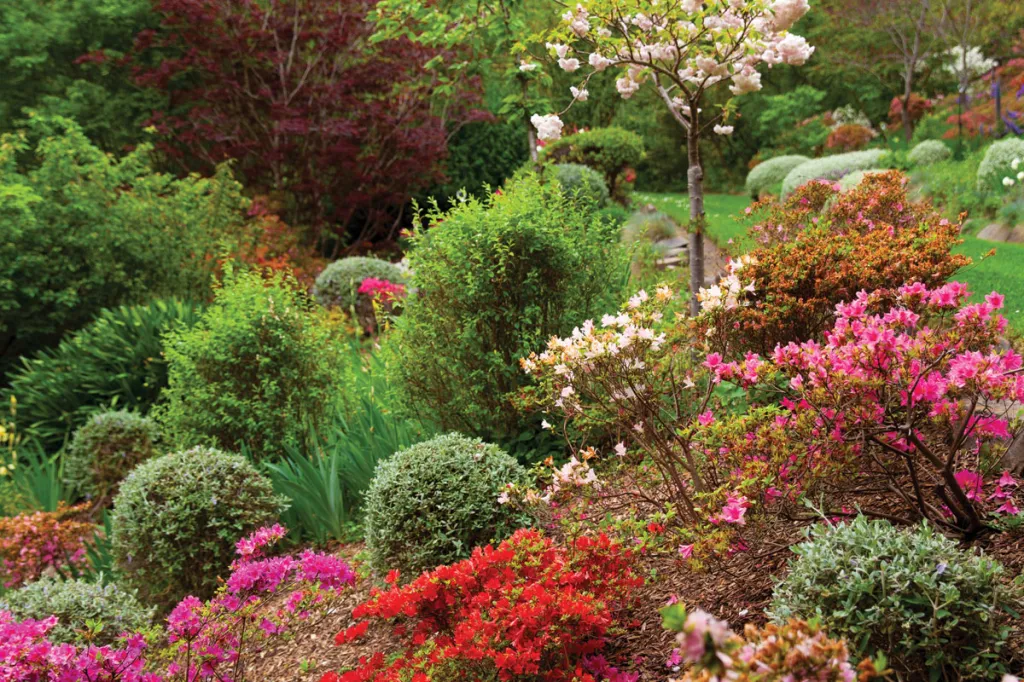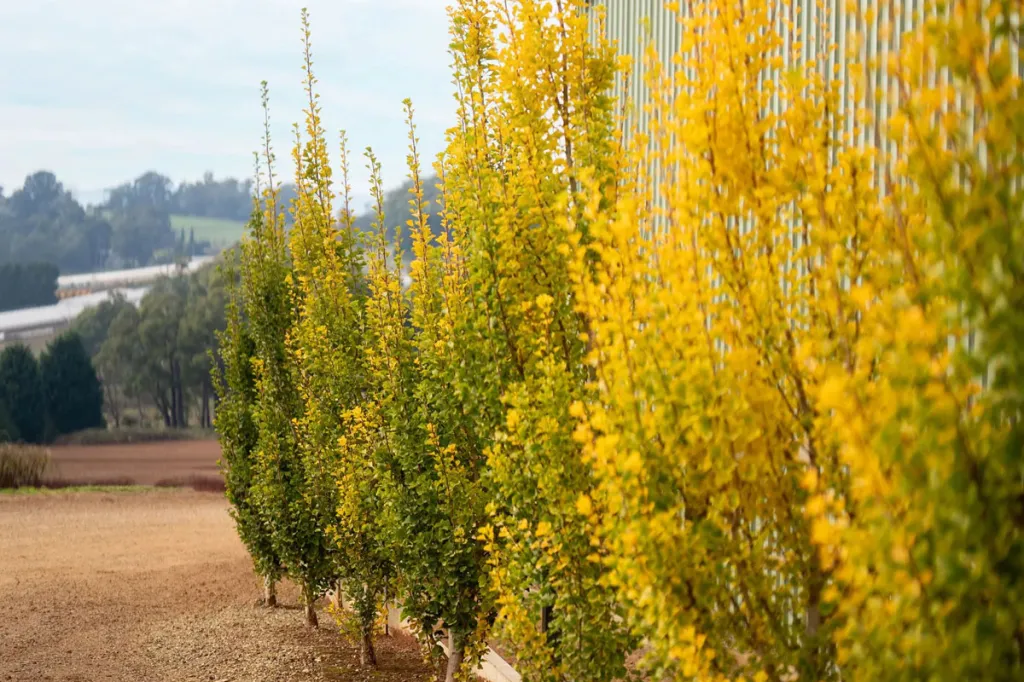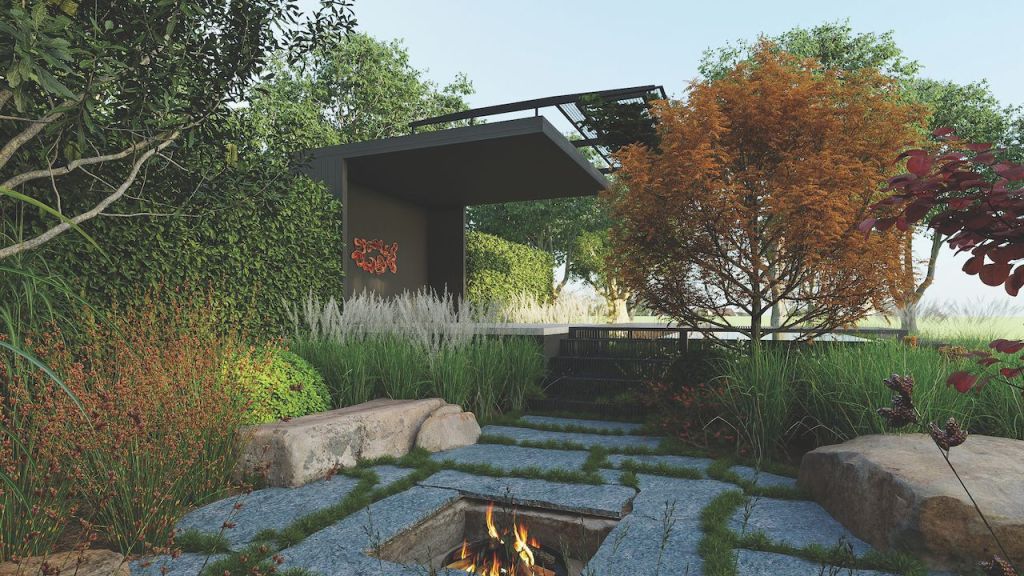A garden where history meets heart
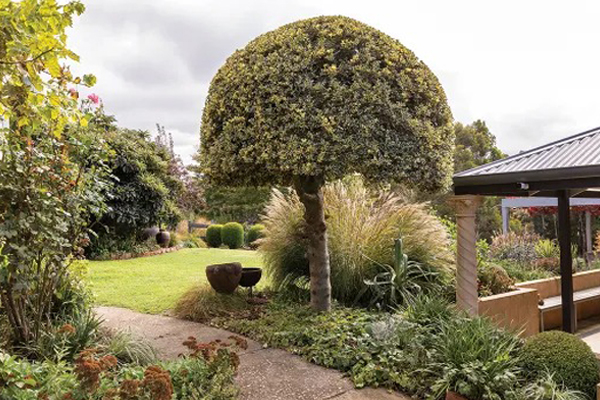
Tucked away in the Adelaide Hills, this “working person’s garden” bursts with diverse flora, including Mediterranean, traditional English, and Australian native plants. Its custodian, Amanda Stewart, takes SALIFE on a special tour.
As SALIFE arrives at Amanda and Paul Stewart’s Adelaide Hills property, we are greeted by its two resident golden retrievers – Kenny and Lola. “They’re very much a part of this garden,” Amanda explains. “You know, they systematically destroy it and make us laugh and I couldn’t imagine the garden without them.”
As you step through the front gate and walk towards the historic house – built just prior to the 1929 Great Depression – you pass through the quaint front garden.
It brims with a fusion of plants such as camellias, clipped box topiary balls in both English (Buxus sempervirens) and Japanese (Buxus microphylla japonica) varieties, as well as roses and perennial grasses.

A wisteria adorns the verandah, while Queen Elizabeth roses, Liriope, agapanthus, Carex and seasonal bulbs are planted near the shed.
Amanda explains that when they purchased the property some two decades ago, not much remained from the original garden.
“The garden hadn’t been maintained for about four years,” Amanda says. “The gentleman was quite elderly and there were really just a handful of fruit trees and a couple of walnuts and a pear tree that were 120 years old. But the bones of the garden were there. So, we’ve slowly added to it over the years.”
This includes planting a forest of blue and red gums that they now use for firewood. The expansive property spans over 10 acres and has several paddocks, a flower garden, a veggie patch and a tree-lined creek.
Amanda started her career as a personal assistant to former South Australian Premier Mike Rann, but after a cancer diagnosis and extensive treatment in her early 30s, she decided she needed a dramatic career change.

A stunning sultana grape vine climbs the wall of the shed. The vine is underplanted with Hydrangea, clipped Japanese Box, lemon balm, mint and seasonal bulbs.
She re-trained in horticulture and garden design and now owns and runs the award-winning Barrow and Bench Mitre 10 hardware store and garden centre on Unley Road, Malvern, with her husband Paul.
Twenty years on and she still loves working with plants.
“I love being in the garden centre; it’s very grounding and it’s really important to me to have plants and nature in my life since that diagnosis,” she says.
Amanda wanders through her Hills paradise and describes Paul and herself as custodians of this “working person’s garden” located on the traditional lands of the Kaurna and Peramangk people.

The Stewarts’ house was built just prior to the Great Depression and among the historic relics they’ve left on display include awards the former owners won for their gladioli at agricultural shows
The property is steeped in history, with remnants of former occupants found throughout, including former farming equipment.
Amanda says it is important to Paul and her that they retain this history and continue to give nods to the former owners, who were daffodil and gladioli growers.
“When we purchased the property, it came with a significant amount of history and we really wanted to honour that history and not just push it aside, so we made sure that we re-used and recycled bits and pieces around the property,” she says
Among the historic features preserved by Amanda and Paul is an engraved step leading to the room of the property’s former caretaker, Steve; pencil handwriting on the back of the shed door indicating the cost (in pounds and shillings), the number and destination of daffodil bulbs grown by the previous owners; timber benches where they bunched and graded daffodils for the cut flower market; a timber storage system for bulbs made from old fruit crates, and the numerous awards the former owners won for their gladioli at agricultural shows.

Amanda and Paul have fused the new with the old in this home; antique tools decorate the 1930s flower shed built from recycled brick, while lanterns provide a modern touch. An old wooden bench is an ideal spot to show off plant cuttings.
As our tour continues, Amanda takes us to some of her favourite plants, including the colourful succulent Sedum ‘Autumn Joy’ (Hylotelephium spectabile), the thistle-like Echinops, the herbaceous perennial purple top vervain (Verbena bonariensis), the ornamental grass ‘Sarabande’ (Miscanthus sinensis), and a panoply of flowering dahlias.
Subscribe for updates
Scattered across the property you will also find pomegranates, a copse of old apple trees, camellias, and a historic walnut tree. The property even has a touch of Carrick Hill, with a holm oak (Quercus ilex) from the historic estate, which was given as a seedling to Amanda.
Amanda says that “one of the marvellous things about owning a nursery or garden centre is that I get to try out plants at home”.
“They don’t all succeed in my environment with such harsh frost and hot, dry summers, but it’s a great way to test plants and I then have the ability to chat to customers in the store about how a plant has grown and what characteristics it has.”

The lovingly cared for front garden features English Box hedging, a lawned area and an eclectic mix of grasses, seasonal bulbs, succulents and perennials. The Stewarts have spent 20 years transforming the property into a green oasis.
She says that maintaining a sustainable garden is especially important. “It’s how I grew up and it’s something that I’ve carried with me all my life, so we try to live as sustainably as possible,” she says.
This means the Stewarts collect rainwater, use solar for electricity and grow 50 per cent of their own firewood, which they use to warm their house and heat water in the winter.
They also have eggs thanks to their ISA Brown chickens which roam the property and also eat their scraps, while their recently sold cattle once acted as lawnmowers – when they weren’t hanging out with Lola and Kenny.

Repurposed blue posts add an extra touch of colour to the veggie patch with its artichoke blooms, potted succulents and perennials. In the background is a stand of magnificent Pin Oaks.
Amanda and Paul also grow a lot of their own fruits and veggies and have revegetated their creek line with acacias, river red gums, stringybarks and a variety of other local provenance trees. The veggie patch has a prominent quandong tree (Santalum acuminatum) – a throwback to Amanda’s childhood on the Yorke Peninsula.
“I grew up with quandong plants. They were native in the scrub on the farm I was raised on and we would often ride our horses through that scrub looking for ripe fruit, which we would eat – fresh and delicious,” she says.
Amanda says one of her favourite things to do in the garden is make relishes, plum and tomato sauces and quince paste.

A fire pit is a favourite winter gathering place and is surrounded by Carex, Rhaphiolepis ‘Oriental Pearl’, Cotyledon orbiculate, bearded iris, Lagerstroemia Diamonds and a Poncirus Flying Dragon tree. In the background are deciduous crab apples, a glory vine and the woodlot.
“It’s always a glut of fruit and veg, particularly in late summer and autumn,” she says. She also loves to pick flowers and gather fallen seeds as decorations, including those from the Bunya pine (Araucaria bidwilli).
Summing up why she loves the property, Amanda says: “The garden is so much more than the garden. It’s about the birds in the bird bath, the eagles that we see in the sky, it’s the koalas in the trees and the kangaroos in the paddock. It’s about the dogs and the people who visit. I mean, the plants are important, but it’s much, much more than the plants.”
This article first appeared in the Winter 2024 issue of SALIFE Gardens & Outdoor Living magazine.
